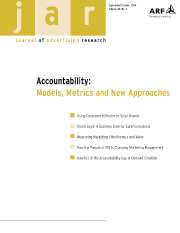Article contents
Editorial: Can IMC Make Channels Come Alive?
Published online by Cambridge University Press: 06 March 2006
Extract
The topic “Broader Strategies for Cross-Channel Integration” clearly calls for two, equally important discussions: one sharing current perspectives on and approaches to Integrated Marketing Communications (IMC) and the other covering new insights about specific, often “nontraditional” communication channels, or what Calder and Malthouse might characterize more expansively as types of “contacts.” This issue of the Journal of Advertising Research (JAR) provides both.
- Type
- EDITORIAL
- Information
- Copyright
- © Copyright © 1960-2005, The ARF
The topic “Broader Strategies for Cross-Channel Integration” clearly calls for two, equally important discussions: one sharing current perspectives on and approaches to Integrated Marketing Communications (IMC) and the other covering new insights about specific, often “nontraditional” communication channels, or what Calder and Malthouse might characterize more expansively as types of “contacts.” This issue of the Journal of Advertising Research (JAR) provides both.
In the JAR's most recent treatment of the subject (March 2004), Bill Cook summarized the evolution of the term “integrated” in “IMC” as having three phases: coordination (emphasizing the communication activity itself), harmony (emphasizing the unity of the composite message to the consumer), and completeness (demanding a qualitatively higher standard than the first two). By advancing an understanding of this evolution, then, the issue sought to help its readers bring into relief “a fuzzy image” of what a mature IMC might look like.
Our current issue continues the discussion with new perspectives and approaches. Launching the publication this quarter is an article that Bobby Calder and Ed Malthouse graciously agreed to prepare and that builds on their thought-provoking article, “What is Integrated Marketing?” from the 2003 book, Kellogg on Integrated Marketing (Iacobucci and Calder, 2003). Their IM paradigm is grounded in a rich and inclusive notion of consumer “contacts,” in contrast to the less “organic” notion of “exposures,” and in the idea that an effective marketing plan designs and configures these experiential contacts in such a way that they “lead [consumers] to the brand concept”: “the idea that the marketer wants the consumer to have, of the way the consumer should experience the product.”
Expanding on this, their new article explores the role of media themselves—not simply the content they convey—in delivering critical and unique dimensions of the “brand-concept” experience to the consumer. Calder and Malthouse's research suggests that a given medium might accomplish this by eliciting images and benefits that the consumer associates with consumption of the medium.
With this overview as a “frame,” the December 2005 edition of the JAR presents a range of thought-provoking writings on IMC generally and on specific channels and brand-building vehicles, many among them qualifying as genuinely “nontraditional” channels. We hope to provide innovative and useful ideas that will help our readers deploy communication and channels more strategically in order to enhance the uniqueness and value of the marketing assets they steward, or that they help others to steward. Please let us know how we do.
References
REFERENCES
- 1
- Cited by


